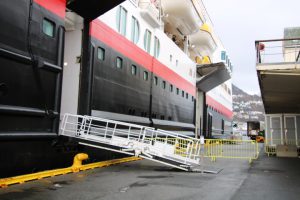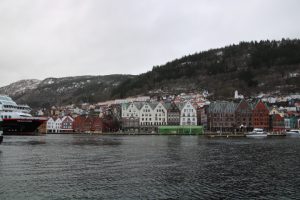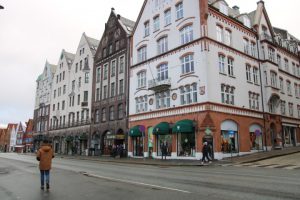Overnight was stormy beyond measure. In fact things were falling off shelves and above us on Deck 5, things were rolling around in a kitchen. At 09:30 this morning the Captain addressed us all and told us that we had had to leave the Inner Passage during the night and enter the open ocean to be able to turn into the fjords for Bergen. This was from 02:00 for about 2 hours. We had winds from the WSW to SW at storm force 8 – 10 gusting at 12 and with 10m waves and we made very slow progress. From our cabin it was impossible to see the sky because of spray. The Captain said, “you are tough because it is rarely as bad as this along the whole of the coast”. He hopes we would be on time in Bergen but that could not be guaranteed. All was calm at breakfast. Between 10:00 and 11:00 a.m. we had to cross another part of the open ocean, which was rough, but this gave us entry into Bergen.
The Inner Passage is a ‘Sea Highway’, largely created by Hurtigruten and its postal ships. This region had historically been known as ‘narrow sounds where sailors were close to fresh water’, but it was the 1893 experiment by Hurtigruten that made towns like Brønnøysund a reliable and permanent port of call. This did the same as railways in the rest of Europe and by the delivery of the twice daily service of the mail and everything else essential opened up the region to trade.
We docked in Bergen at lunchtime.
During the early Middle Ages the city was an important sea port and a member of the Hanseatic League. This was a trading union of ports across northern Europe and in particular Germany, Denmark, Netherlands, the UK and Scandinavia. The preserved warehouses and trading buildings are known as the Bryggen, which translates as ‘wharf’. Each building had a crane for loading and unloading ships and encouraged traders from other Norwegian towns to either trade through Bergen or develop their own networks.
For example, Kristiansund, had a town charter from 1742 and the trading rights based upon the ‘klippfisk’ (dried cod) which were brought to the town by a Dutch trader called Jappe Ippe in the 1690s. He received the ‘Letter of Privilege’ to trade fish in the town. Shortly afterwards a Scotsman called John or Jack Ramsay overtook the production of the cod and is today commemorated in a restaurant/bar on Bergen’s waterfront. By now the power of the Hanseatic League was declining and left to the Dutch and English to take over the trade. In Kristiansund it is interesting to note that the ships that took the dried cod to Spain returned with Spanish soil as ballast. There was little soil around the town and this ballast was used initially to make the cemetery and from this time the deceased of the town rest in soil from the southwest of Europe.










